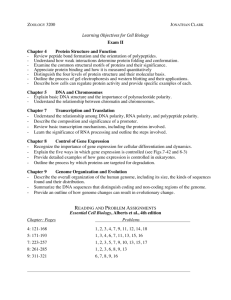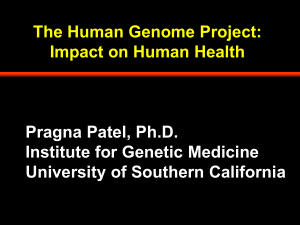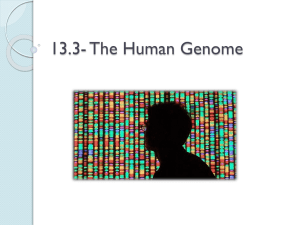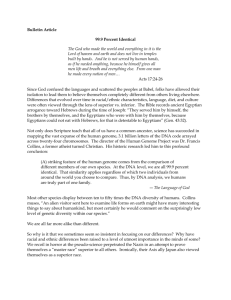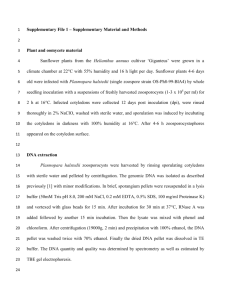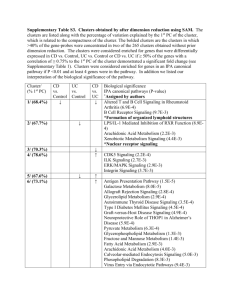list of 50 Core Area Choices
advertisement
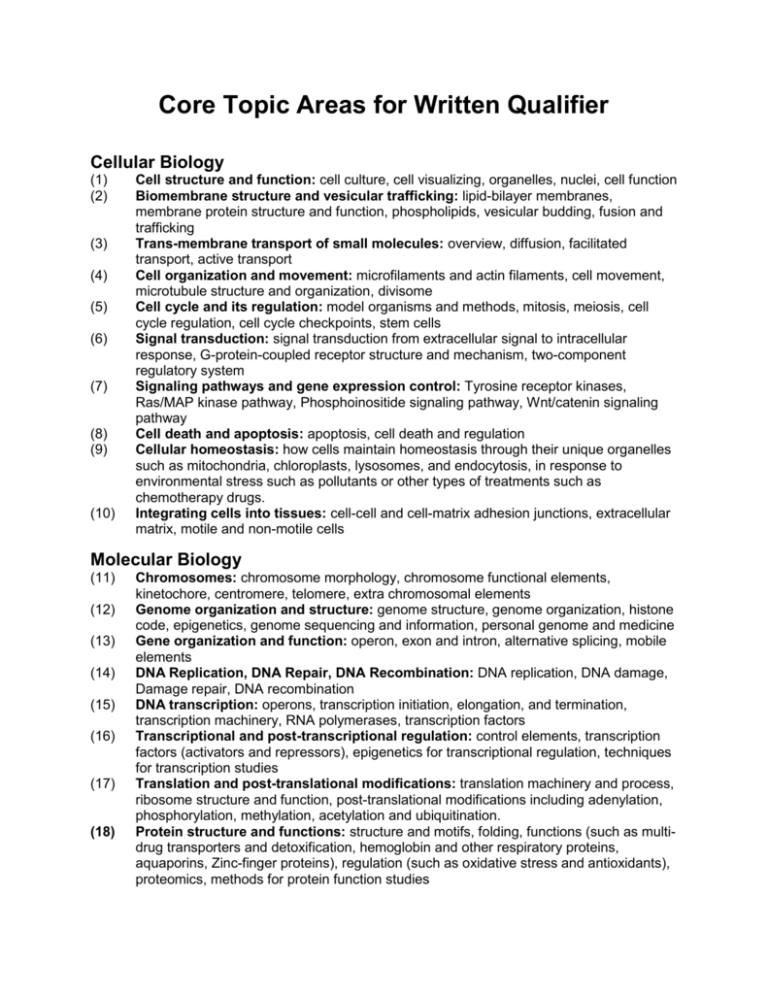
Core Topic Areas for Written Qualifier Cellular Biology (1) (2) (3) (4) (5) (6) (7) (8) (9) (10) Cell structure and function: cell culture, cell visualizing, organelles, nuclei, cell function Biomembrane structure and vesicular trafficking: lipid-bilayer membranes, membrane protein structure and function, phospholipids, vesicular budding, fusion and trafficking Trans-membrane transport of small molecules: overview, diffusion, facilitated transport, active transport Cell organization and movement: microfilaments and actin filaments, cell movement, microtubule structure and organization, divisome Cell cycle and its regulation: model organisms and methods, mitosis, meiosis, cell cycle regulation, cell cycle checkpoints, stem cells Signal transduction: signal transduction from extracellular signal to intracellular response, G-protein-coupled receptor structure and mechanism, two-component regulatory system Signaling pathways and gene expression control: Tyrosine receptor kinases, Ras/MAP kinase pathway, Phosphoinositide signaling pathway, Wnt/catenin signaling pathway Cell death and apoptosis: apoptosis, cell death and regulation Cellular homeostasis: how cells maintain homeostasis through their unique organelles such as mitochondria, chloroplasts, lysosomes, and endocytosis, in response to environmental stress such as pollutants or other types of treatments such as chemotherapy drugs. Integrating cells into tissues: cell-cell and cell-matrix adhesion junctions, extracellular matrix, motile and non-motile cells Molecular Biology (11) (12) (13) (14) (15) (16) (17) (18) Chromosomes: chromosome morphology, chromosome functional elements, kinetochore, centromere, telomere, extra chromosomal elements Genome organization and structure: genome structure, genome organization, histone code, epigenetics, genome sequencing and information, personal genome and medicine Gene organization and function: operon, exon and intron, alternative splicing, mobile elements DNA Replication, DNA Repair, DNA Recombination: DNA replication, DNA damage, Damage repair, DNA recombination DNA transcription: operons, transcription initiation, elongation, and termination, transcription machinery, RNA polymerases, transcription factors Transcriptional and post-transcriptional regulation: control elements, transcription factors (activators and repressors), epigenetics for transcriptional regulation, techniques for transcription studies Translation and post-translational modifications: translation machinery and process, ribosome structure and function, post-translational modifications including adenylation, phosphorylation, methylation, acetylation and ubiquitination. Protein structure and functions: structure and motifs, folding, functions (such as multidrug transporters and detoxification, hemoglobin and other respiratory proteins, aquaporins, Zinc-finger proteins), regulation (such as oxidative stress and antioxidants), proteomics, methods for protein function studies Hypothesis Testing (19) Statistical Methodology and Experimental Interpretation Evolutionary Biology (20) (21) (22) (23) (24) (25) (26) (27) (28) (29) (30) (31) (32) (33) Genes and Mutation: gene structure, types and rates of mutation, pseudogenes, transcribed genes Genome Evolution: genome size, gene duplication, nongenic sequences, chromosomal evolution Hardy-Weinberg Principle and Population Genetics: allele frequencies, genetic drift, fixation, stasis, neutral theory of molecular evolution Natural Selection: Principles and Mechanisms: criteria, types of selection, mechanisms of selection, statistical and comparative analyses for evidence of selection. Mechanisms of Speciation: genetic isolation, divergence, hybridization, loci of speciation Evolution of Sex and Life History: ploidy, recombination, origin and costs of sex, cytoplasmic inheritance, alteration of generations Evolution of Development: genetic switches, origins and consequences of novelty, gene regulatory networks, modularity, and evolutionary constraint Molecular Phylogenetics: homology, gene and protein families, principles of phylogenetic inference and reliability, molecular clock hypothesis Co-evolution: Red Queen effect, symbioses, role in emerging pathogens (antigen switching, host jumping, etc.), arms race, disease evolution Bioinformatics and Quantitative Genetics: databases, BLAST, molecular modeling, sequence homology and structure inferences, QTL mapping, linkage, genome wide association studies Origin and Diversity of Life: RNA world, extant domains of life, horizontal gene transfer, role of endosymbiosis in eukaryotic evolution Evolutionary Epigenetics: transgenerational inheritance of non-coding loci, mutation bias, role in phenotypic plasticity, role in cancer Human Evolution: origins, migration, genetic differentiation, pedigree analysis, emergence of novel mutations in recent human history Metagenomics: microbial diversity and environmental association, speciation by symbiosis, host-associate co-evolution Environmental Biology (34) (35) (36) (37) Climate and Global Warming: The Atmosphere, Solar Radiation, Ocean/Atmosphere Circulation, The Earth’s Climate and Climate Variation, The Earth’s Climate and Climate Variation, Greenhouse Gases, Climate Feedbacks, Past Climate Change, Anthropogenic Climate Change Causes, Anthropogenic Climate Change Consequences Biological Productivity and Energy Flow: Autotrophy and Primary Production, Constraints on Primary Production, Chemosynthesis, Heterotrophy and Secondary Production, Energy Flow and Food Webs Nutrient Cycles: Nutrient Cycles Overview, The Nitrogen Cycle, The Phosphorus Cycle, Carbon Reservoirs, The Long Term Carbon Cycle, The Marine Carbon Cycle, Ocean Acidification, The Terrestrial Carbon Cycle, Human Alterations to the Carbon Cycle, Fossil Fuel Use Environmental Impact on Population Biology: Abundance and Distribution of Organisms, Coping with Environmental Variation, Population Growth and Dynamics, Isle Royale Wolves, Human Population Growth (38) (39) (40) Ecosystems and Communities: Ecological Interactions, Ecological Interactions, Multispecies Interactions, Community Structure, Community Changes Environment and Biological Diversity: What is Biodiversity?, Biogeography, What Determines Biodiversity?, Does Biodiversity Matter?, Loss of Biodiversity, Conservation Biology Pollution, Toxicology, and Environmental Health: Air Pollution, Stratospheric Ozone Depletion, Water Pollution and Treatment, Basic Toxicology, Heavy Metal Pollutants, Organic Pollutants, Ecology of Infectious Disease Biochemistry, Biological Pathways, and Metabolism (41) (42) (43) (44) (45) (46) (47) (48) (49) (50) Proteins: structure and function, protein-protein interactions Enzymes, catalysis, and kinetics: Mechanisms of catalysis, control flow through pathways, allosteric regulation. Membrane proteins including channels and receptors: Structure/ principles of membrane proteins, receptor binding specificity, regulation of information flow by membrane proteins. Nucleic acids structure and biochemical synthesis: Purine and pyrimidine synthesis and catabolism, de novo synthesis and salvage pathways Hormones and Hormone receptors: Evolution of hormone signaling, hormone / receptor binding specificity and kinetics, Downstream signaling pathways, Information signaling via hormones. Antibodies and Antigens: Antibody structure and specificity, Antibodies as experimental tools. Redox signaling and cell defense mechanisms: Chemistry of reactive oxygen and nitrogen species, Pleiotropic effects of free radicals, Energy metabolism: Alternative pathways of energy transduction, evolutionary and functional diversity of energy metabolism, Aerobic / anaerobic metabolism, alternate electron acceptors, control of energy flow Carbohydrate/lipid metabolism: Evolutionary aspects of carbohydrate/ lipid metabolism, regulation of substrate utilization in response to nutritional state, Energy production/ storage, biosynthesis of carbohydrate/ lipid. Adenylates and other high-energy phosphates: Energy conservation in the form of “high energy phosphates”, Thermodynamics of cellular energy storage/ transfer, Mechanisms of conversion of ATP to physical or chemical work.
